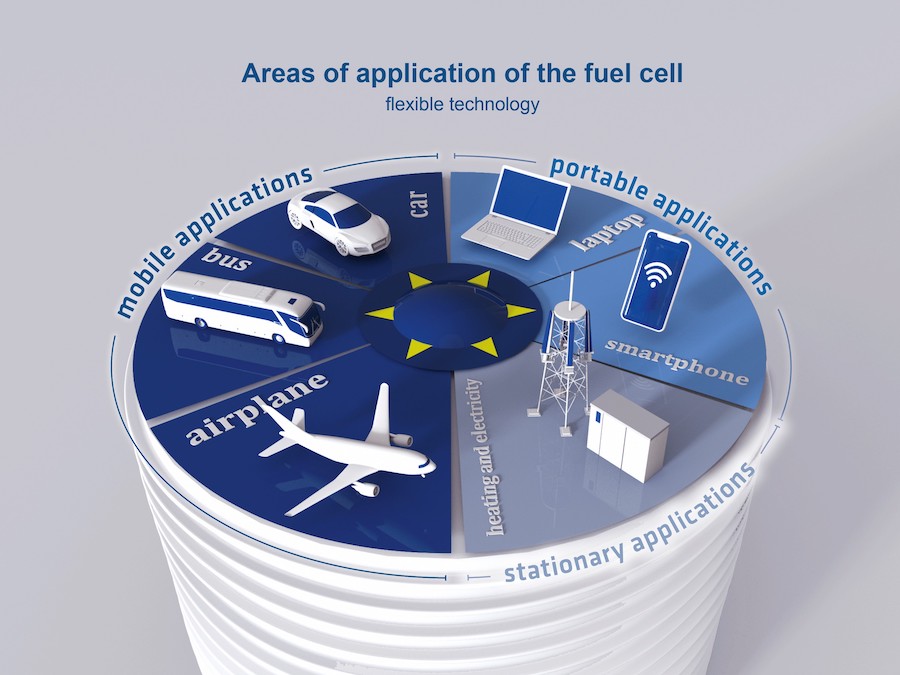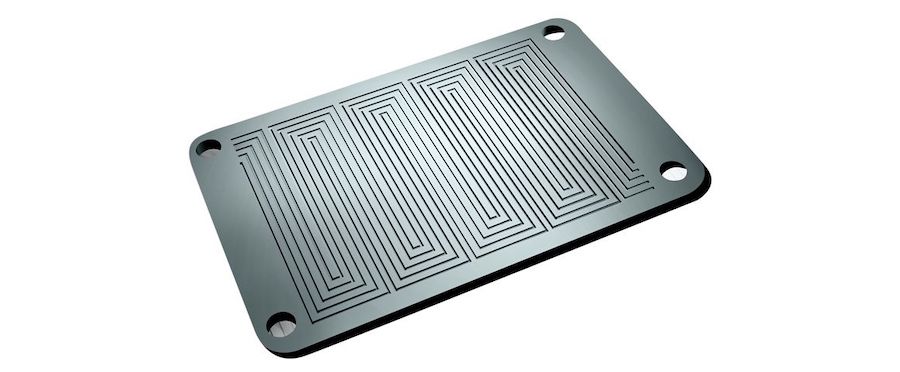High-Performance Plastics in Fuel Cells for Emission-Free Mobility
Ensinger
The topic of emission-free mobility has become quite familiar to the average person today. In a time when sustainability is more critical than ever, engineers and researchers are continuously seeking solutions to the arduous carbon-emission problem, particularly in the energy and transportation sectors. One technology that has gained momentum over recent years is the fuel cell. Considered an appropriate alternative to the traditional combustion engine, the fuel cell requires high-performance materials that enable it to operate as efficiently as possible. This is where Ensinger’s TECACOMP HTE materials come into play. As high-performance engineering thermoplastics, TECACOMP HTE compounds have excellent mechanical, thermal, and electrical properties rendering them highly reliable materials for bipolar plates in fuel cells.

Credit: Ensinger Plastics.
The fuel cell and its environmental impact
A fuel cell is an electrochemical system that converts chemical energy to electrical energy. It basically runs like a battery but does not decay or require recharging. It simply keeps functioning as long as there is a fuel supply. Most fuel cells are based on hydrogen and oxygen, which enables electricity generation with the harmless byproduct, water. This positions fuel cells as the eco-friendly alternative to internal combustion engines, for example, which are known for their carbon dioxide emissions. Other fuels are also used for energy conversion, including methanol, butane, and natural gas.
Given their high efficiency and environmental advantages, fuel cells have found their way into many application areas, including the transportation sector, consumer electronics, satellites, and more. All this comes as a result of their mode of operation and the materials that constitute their parts.
The most commonly used fuel cell today, especially in vehicle applications, is the polymer electrolyte membrane (PEM) fuel cell. Also known as the proton-exchange membrane fuel cell, the PEM fuel cell’s operation is centered around the membrane electrode assembly (MEA). This combination of layers includes the proton-exchange membrane itself, catalyst layers, and gas diffusion layers (GDL). This assembly is supported by gaskets to ensure no gas leakage takes place and bipolar plates, which transport the reactant gases from the MEA to the endplates. In fact, not only do bipolar plates serve as channels for the reactants, but they also help assemble stacks of PEM fuel cells.
The role of bipolar plates in fuel cells
Fuel cells are generally utilized in stacks due to the demand for high voltages in most applications. That is why many MEAs are stacked on top of one another in a series connection, combining to produce a sufficient useful voltage. This is where bipolar plates come into play.
Bipolar plates sandwich each fuel cell to separate it from the adjacent cells. These plates offer good conductivity - both electric and thermal - and sufficient mechanical strength to endure the contact pressure in the cell. Each plate has multiple channels machined into it, known as “flow field.” These channels permit the gas flow over the adjoining MEA. Other channels are also used for coolant circulation, and in that manner, bipolar plates separate the reaction gases from the cooling media and distribute them into the reaction zones.
Bipolar plates can be made of metal, carbon, or polymeric composites. In effect, polymeric materials have shown clear advantages over other materials, especially taking into account the weight, volume, and cost contributions.

Credit: Ensinger Plastics.
Ensinger, a leading producer of high-performance plastics, have developed highly filled thermoplastics called TECACOMP HTE, particularly for the use in bipolar plates of fuel cells. TECACOMP-HTE-based bipolar plates stand out thanks to their excellent electrical and thermal conductivity, permeability, and mechanical strength. These engineering thermoplastics are suitable for injection moulding and hot compression processing, and they are optimized to resist the chemical media inside the fuel cell. This gives them a clear advantage over metal-based bipolar plates, which would require costly chemical-resistant coatings to be layered on top before stack assembly. As a result, such thermoplastics have extended the service life of bipolar plates four times longer than metal plates.
The table below shows a list of the TECACOMP HTE materials provided by Ensinger and some of their key properties. These are produced as a powder or granules based on either polypropylene (PP) or polypropylene sulfide (PPS).
Table 1. Key properties of Ensinger’s TECACOMP HTE compounds.
|
|
TECACOMP PP HTE black 1014973 |
TECACOMP PP HTE PW black 1014974 |
TECACOMP PPS HTE black 1017672 |
TECACOMP PPS HTE PW black 1014976 |
|
Density (23.0 °C) |
1.87 g/cm³ |
1.94 g/cm³ |
1.88 g/cm³ |
2.00 g/cm³ |
|
Water absorption |
0.1 % |
0.1 % |
0.1 % |
0.1 % |
|
Flexural strength (23.0 °C) |
40 MPa |
33 MPa |
40 MPa |
40 MPa |
|
Impact strength, Charpy unnotched (23.0 °C) |
1.7 kJ/m² |
1.5 kJ/m² |
1.4 kJ/m² |
1.3 kJ/m² |
|
Max service temperature |
90 - 130 °C |
90 - 130 °C |
200 - 280 °C |
200 - 280 °C |
|
Flammability |
UL94 class HB, DIN IEC 60695-11-10 |
|||
|
Electrical conductivity (23.0 °C) |
2500 S/m |
16800 S/m |
6660 S/m |
14200 S/m |
|
Fillers (90 % by weight) |
Graphite |
Graphite |
Graphite |
Graphite |
With such materials, bipolar plates can be highly effective in supporting fuel cells to efficiently allow emission-free energy conversion and reduce the carbon footprint of many applications. Ensinger has made sure that these compounds are well-tested and ready for use in demanding conditions. As the key account manager at Ensinger, Joachim Reidenbach, expressed: “We are currently receiving a great many enquiries about our TECACOMP HTE materials, which have been tried and tested in practice. Ensinger is prepared for this trend and can also manage production quantities of over 200 tonnes.”
About Ensinger
Ensinger Compounds develops and produces high-performance compounds (high-performance plastics) with fillers and additives whose formulations are precisely and individually adjusted in line with the customer’s requirements, making them suitable for a varied range of technical applications. Ensinger’s portfolio comprises formulations that are electrically conductive, thermally conductive, abrasion and wear-optimized, detectable and designed to permit laser direct structuring. Today, Ensinger is collaborating with Matmatch to bring materials like TECACOMP HTE closer to engineers and product developers seeking high-performance materials for their projects.
Article by Ensinger GmbH
High Performance Plastics: Ensinger Compounds develops and produces high-performance compounds with fillers and additives whose formulations are precisely and individually adjusted in line with the customer’s requirements, making them suitable for a varied range of technical applications.
Our portfolio comprises formulations which are electrically conductive, thermally conductive, abrasion and wear-optimized, detectable and designed to permit laser direct structuring. The structure of the company, the specialization of its employees and its widely diverse machine equipment outfit lends us the flexibility required to offer you optimum service, whether for small quantities or large-scale series production.

